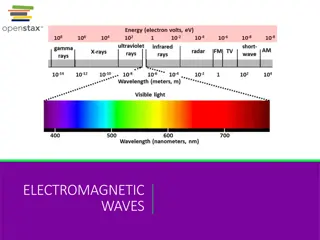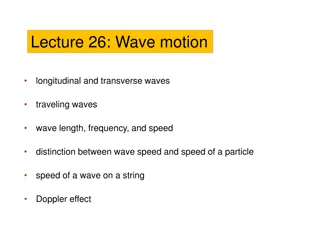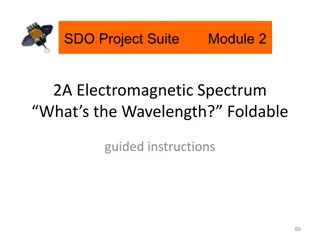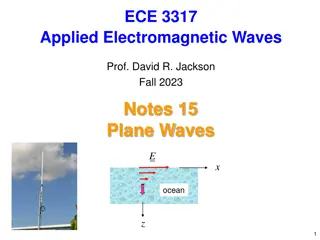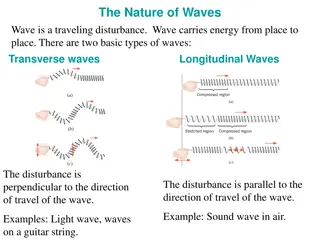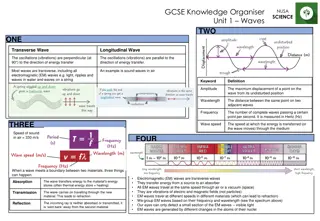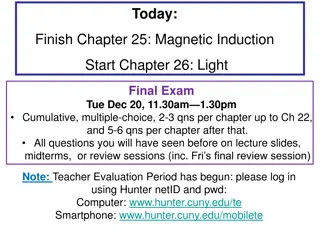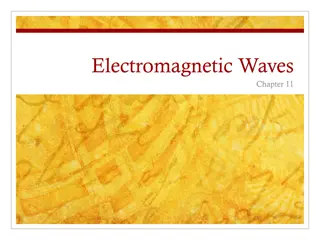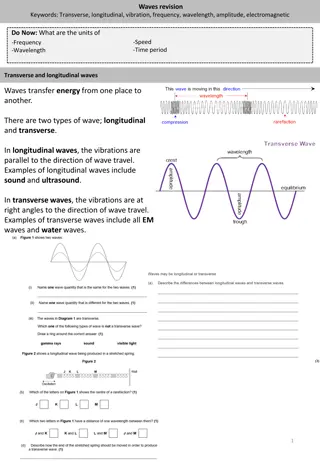Understanding Electromagnetic Waves: Speed, Spectrum, and Applications
Electromagnetic waves are characterized by the interplay between changing magnetic and electric fields, propagating at the speed of light in a vacuum. This speed, denoted by 'c,' is a fundamental constant. The electromagnetic spectrum encompasses a range of frequencies and applications, from radio and TV reception to wireless capsule endoscopy and cochlear implants. Additionally, the speed of light has been precisely measured and is utilized in defining the meter. Explore the diverse nature and practical implications of electromagnetic waves in various fields.
Download Presentation

Please find below an Image/Link to download the presentation.
The content on the website is provided AS IS for your information and personal use only. It may not be sold, licensed, or shared on other websites without obtaining consent from the author. Download presentation by click this link. If you encounter any issues during the download, it is possible that the publisher has removed the file from their server.
E N D
Presentation Transcript
The Nature of Electromagnetic Waves The changing magnetic field creates an electric field that fluctuates in time and the changing electric field creates the magnetic field.
Speed of Electromagnetic Waves All electromagnetic waves move through a vacuum at the same speed, and the symbol c is used to denote its value. This speed is called the speed of light in a vacuum and is c = 3.00 108 m/s. In air, electromagnetic waves travel at nearly the same speed as they do in a vacuum, but, in general, they move through a substance such as glass at a speed that is substantially less than c. In 1865, Maxwell determined theoretically that electromagnetic waves propagate through a vacuum at a speed given by,
24.2. The Electromagnetic Spectrum = c f
24.3. The Speed of Light The time required for light to travel between two places on earth is very short. 1907 Nobel prize winner, Michelson used a rotating eight-sided mirror to measure the speed of light. Today, the speed of light has been determined with such high accuracy that it is used to define the meter. c = 299,792,458 m/s
Radio and TV reception This cruise ship uses both straight wire and loop antennas to communicate with other vessels and on-shore stations. A radio wave can be detected with a receiving antenna wire that is parallel to the electric field of the wave. With a receiving antenna in the form of a loop, the magnetic field of a broadcasted radio wave can be detected.
Cochlear Implant Hearing-impaired people can recover part of their hearing with the help of a cochlear implant. The broadcasting and receiving of electromagnetic waves lies at the heart of this device.
Wireless Capsule Endoscopy This wireless capsule endoscope is designed to be swallowed. As it passes through a patient s intestines, it broadcasts video images of the interior of the intestines.
Crab Nebula Four views of the Crab Nebula, which is the remnant of a star that underwent a supernova explosion in 1054 AD. It is located 6300 light-years away from the earth.
How a microwave heats food? In a microwave oven, the rotating fan blades reflect the microwaves to all parts of the oven and water molecules in the food absorb it. The absorption occurs because each water molecule has a permanent dipole moment. The electric field of the microwaves exerts forces on the positive and negative ends of a molecule, causing it to spin. As the internal energy increases, the temperature of the water increases, and the food cooks.
The Greenhouse Effect The energy carried by electromagnetic waves in the infrared and visible regions of the spectrum plays the key role in the greenhouse effect that is a contributing factor to global warming.
24.5. The Doppler Effect and Electromagnetic Waves When electromagnetic waves and the source and the observer of the waves all travel along the same line in a vacuum (or in air, to a good degree of approximation), the single equation that specifies the Doppler effect is,
Polarized Light The electromagnetic waves emitted by any common source of light (such as the Sun or a bulb) are unpolarized or polarized randomly. That is, the electric field at any given point is always perpendicular to the direction of travel of the waves but changes directions randomly.


